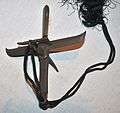Jitte
A jitte or jutte (十手, "ten hands") is a specialized weapon that was used by police in Edo period Japan.[1][2]
History
In feudal Japan, it was a crime punishable by death to bring a sword into the shōgun's palace. This law applied to almost everyone, including the palace guards. Due to this prohibition, several kinds of non-bladed weapons were carried by palace guards. The jitte proved particularly effective and evolved to become the symbol of a palace guard's exalted position.[3]
In Edo period Japan the jitte was a substitute for a badge, and it represented someone on official business. It was carried by all levels of police officers, including high-ranking samurai police officials and low-rank samurai law enforcement officers (called okappiki or doshin).[4][5] Other high-ranking samurai officials carried a jitte as a badge of office,[6] including hotel, rice and grain inspectors (aratame).[7][8] The jitte is the subject of the Japanese martial art of jittejutsu.[9]
Description and technique
Jitte may have a small pointed tip or blade attached to the handle (tsuka) and hidden in the shaft (boshin). Jitte could be highly decorated with all manner of inlays and designs or very plain and basic depending on the status of the owner and the jitte's intended use. Jitte could range in length from around 12 to over 24 in (30–61 cm).[10] The modern jitte is about 45 cm (18 in) long with no cutting edge and a one-pronged tine (kagi) about 5 cm (2.0 in) long starting just above the hilt and pointing toward the tip (sentan). A popular misconception is that the kagi is used to catch a sword. It could possibly be used for this purpose, but the hook's proximity to the hand would make it rather dangerous; a more likely use for the hook would be to capture and arrest the blade after blocking it with the boshin.[11] The kagi's more common use is to hook into clothing or parts of the body like the nose or mouth, or to push into joints or other weak points on the body. It also could be used to hook the thumb while holding the weapon backwards, to allow different techniques such as punches and blocks, very similarly to a sai. The jitte can also be used in much the same manner as other short sticks or batons, to strike large muscle groups and aid in joint manipulation.[11]
Parts of the jitte
- Boshin, the main shaft of the jitte which could be smooth or multi sided. The boshin of most jitte were usually iron but some were made from wood.[13]
- Sentan, the tip or point of the jitte.
- Kagi, the hook or guard protruding from the side of the jitte. Jutte may have more than one kagi with some jitte having two or three kagi.[10]
- Kikuza (chrysanthemum seat): if the kagi is attached to the boshin through a hole in the boshin, the protrusion on the opposite side is called a kikuza.
- Tsuka, the handle of the jitte which could be left plain; it could also be wrapped or covered with various materials.
- Tsukamaki, the wrapping on the handle (tsuka). Materials such as ray skin (same'), same' leather, and cord were used for tsukamaki on jittes.
- Kan, the ring or loop at the pommel of the tsuka. A cord or tassel could be tied to the kan. Also note its 'skull cracker' design.
- Tsuba, a hand guard present on some types of jitte.
- Koshirae. Jitte can occasionally be found housed in a sword type case hiding the jitte from view entirely, this type of jitte can have the same parts and fittings as a sword including:seppa, tsuba, menuki, koiguchi, kojiri, nakago, mekugi-ana and mei.
Other jitte types and similar weapons
Gallery
.jpg) The sentan' (tip or point) of a jitte with a hexagon boshin (shaft)
The sentan' (tip or point) of a jitte with a hexagon boshin (shaft) The tsuka (handle) showing the ray skin (same') tsukamaki (handle wrap)
The tsuka (handle) showing the ray skin (same') tsukamaki (handle wrap) The kan (end loop)
The kan (end loop)- The kagi (hook)
 Naesshi or nayashi jitte, a hookless jitte
Naesshi or nayashi jitte, a hookless jitte- A jutte with a wooden shaft
- An antique jitte with a hexagon boshin (shaft)
- A matched pair of iron jutte and two kagi (hooks), similar to a sai, copper covered tsuka (handle) and iron kan (end loop) with tassel
 Karakuri jitte
Karakuri jitte
References
- Draeger & Smith (1969). Comprehensive Asian Fighting Arts. p. 83. ISBN 978-0-87011-436-6.
- Serge Mol, Classical weaponry of Japan: special weapons and tactics of the martial arts, Kodansha International, 2003; p.221
- Jutte (Ju-Te): The "Power-of-Ten-Hands" Weapon
- Stephen Turnbull, The Samurai Swordsman: Master of War, p.113
- Don Cunningham, Taiho-Jutsu: Law and Order in the Age of the Samurai, Tuttle Publishing, 2004; p.65
- Serge Mol, Classical weaponry of Japan: special weapons and tactics of the martial arts, pp.77–78
- Cunningham, p.72
- William E. Deal, Handbook to life in medieval and early modern Japan, pp.166–167
- Serge Mol, Classical weaponry of Japan: special weapons and tactics of the martial arts, Kodansha International, 2003
- Cunningham, p.66
- Serge Mol, Classical weaponry of Japan: special weapons and tactics of the martial arts, Kodansha International, 2003; p.80
- Daniel C. Pauley, Samantha Pauley, Pauley's Guide: A Dictionary of Japanese Martial Arts and Culture, 2009, p.65
- Thomas Louis, Tommy Ito, Samurai: The Code of the Warrior, Sterling Publishing Company, Inc., 2008; p.129
External links
| Wikimedia Commons has media related to Jutte. |
| Wikimedia Commons has media related to Koshirae (jutte). |
| Wikimedia Commons has media related to Tsuba (jutte). |